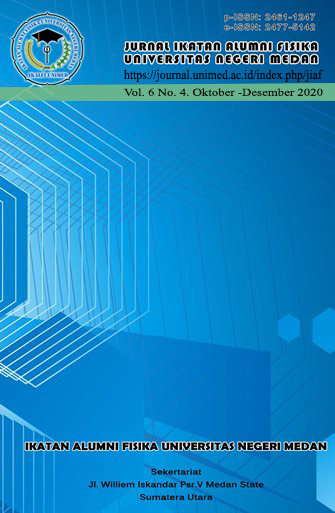Pemahaman Konsep Mahasiswa IPA pada materi Hukum Newton
DOI:
https://doi.org/10.24114/jiaf.v6i4.21293Keywords:
Pendidikan FisikaAbstract
Pemahaman konsep merupakan suatu cara untuk memahami dan mengemukakan suatu ide yang diperoleh secara sistematis. Tujuan penelitian ini adalah untuk mengetahui pemahaman konsep mahasiswa IPA pada materi hukum Newton. Metode penelitian yang digunakan adalah deskriptif Kualitatif. Data dikumpulkan berdasarkan observasi, tes, dan wawancara. Sampel yang digunakan adalah mahasiswa semester I Pendidikan IPA STKIP Modern Ngawi sebanyak 28 mahasiswa. Instrumen tes yang digunakan adalah soal Force Concept Inventory (FCI). Berdasarkan hasil penelitian diperoleh informasi bahwa sebagian besar mahasiswa mengalami kesalahan konsep pada materi hukum I, II. dan III Newton. Sebanyak 36% mahasiswa memiliki jawaban benar pada persoalan Hukum I Newton. Sebanyak 40% mahasiswa memiliki jawaban benar pada persoalan hukum II Newton. Kemudian sebanyak 47% mahasiswa memiliki jawaban benar pada persoalan Hukum III Newrton. Hasil analisis menunjukkan bahwa sebagian besar kesalahan konsep mahasiswa adalah intuisi.Kata kunci : Pemahaman Konsep, Hukum Newton ABSTRACTUnderstanding the concept is a way to understand and express an idea obtained systematically. This study aimed to determine the understanding of the concept of science students in Newton's law material. The research method used is descriptive qualitative. Data collected based on observation, tests, and interviews. The sample used is the first semester students of STKIP Modern Ngawi Science Education, as many as 28 students. The test instrument used was the Force Concept Inventory (FCI) question. Based on the study results, it was found that most of the students had misconceptions in legal material I, II., and III Newton. As many as 36% of students have the correct answer to Newton's First Law problems. As many as 40% of students have the right solution to Newton's second law problem. Then as many as 47% of students have the correct answer to Newton's Third Law problem. The results of the analysis showed that most of the students' misconceptions were intuitionKeywords: Conceptual Understaning, Newton™s LawReferences
Arslan, A., S., & Devecioglu., Y. (2010). Student teachers™ levels of understanding and model of understanding about Newton's laws of motion. Journal Asia-Facifik Forum on Science Learning and Teaching, 1(1), 1.
Azita Seyed, Fadaei. Cesar, Mora. (2015). An Investigation About Misconception in Force and Motion in High School. US-china education review, 5(1), 38”45.
Chee, T. C. (2010). Common Misconceptions in Frictional Force among University Physics Students. Journal on Teaching and Learning, 16(2), 107”116.
Dimas, A, Suparmi, Sarwanto, & Nugraha, D. A. (2018). Analysis multiple representation skills of high school students on simple harmonic motion. AIP Conference Proceedings. 2014(9), https://doi.org/ 10.1063/1.5054535
Handhika, J., Cari, Suparmi & Sunarno, W. (2015b). Student Conception and Perception of Newton™s Law. Proceedings of International Seminar on Mathematics, Science, and Computer Science Education. AIP Conference Proceeding.
Hestenes, D., Wells, M., dan Swackhamer, G. 1992. Force Concept Inventory. The Physics Teacher. 30. 141-158
Lee, G (2007). Why do students have difficulties in learning physics? Toward a structural analysis of student difficulty via a framework of knowledge and belief, New physics (The Journal of Korean Physical Society).
Lona, Y. D., Kamaluddin, K., & Fihrin, F.(2013).Analisis Hirarki Pemahaman Siswa Kelas XA SMA Negeri 5 Palu Pada Materi Hukum Newton. Jurnal Pendidikan Fisika Tadulako (JPFT), 1(1).
Nursefriani, P. M., & Kamaluddin, H.(2016). Analisis Pemahaman Konsep Siswa SMA Lab-School Palu pada Materi Hukum Newton. Jurnal Pendidikan Fisika Tadulako (JPFT), 4(2)
Published
Issue
Section
License
Copyright (c) 2020 JURNAL IKATAN ALUMNI FISIKA UNIVERSITAS NEGERI MEDAN

This work is licensed under a Creative Commons Attribution 4.0 International License.
Authors who publish with this journal agree to the following terms:- Authors retain copyright and grant the journal right of first publication with the work simultaneously licensed under a Creative Commons Attribution License that allows others to share the work with an acknowledgement of the work's authorship and initial publication in this journal.
- Authors are able to enter into separate, additional contractual arrangements for the non-exclusive distribution of the journal's published version of the work (e.g., post it to an institutional repository or publish it in a book), with an acknowledgement of its initial publication in this journal.
- Authors are permitted and encouraged to post their work online (e.g., in institutional repositories or on their website) prior to and during the submission process, as it can lead to productive exchanges, as well as earlier and greater citation of published work (See The Effect of Open Access).


 Jl. Williem Iskandar Psr. V, Medan Estate, Kec. Percut Sei Tuan, Kabupaten Deli Serdang, Sumatera Utara 20221
Jl. Williem Iskandar Psr. V, Medan Estate, Kec. Percut Sei Tuan, Kabupaten Deli Serdang, Sumatera Utara 20221